I’ve had large breasts for my entire life. Sometime around the end of elementary school and beginning of middle school, my body started to develop and it felt like it was never going to stop. By high school, I was a DD cup. Through college, I surpassed a DDD, E, and F (which were sizes I didn’t even know existed!). Finally, in my late-20s, my breasts settled at an H cup, which I was completely comfortable with. These were my breasts, I told myself almost every day as I got dressed. Why would I change them?
It turns out, change isn’t always a bad thing.

Considering Breast Reduction Surgery? Everything I Wish I Knew Before I Got One
When I was 18, my mom asked if I wanted to get a breast reduction. Her sister had gone through the procedure when she was younger and it had been a very positive experience for her. She explained that a breast reduction was a procedure typically performed by a plastic surgeon to remove excess breast tissue and skin in order to reduce the size of the breasts for either cosmetic or health-related reasons (or both!).
Breast reductions are one of the most commonly performed plastic surgeries in the United States- the American Board of Plastic Surgeons reports nearly 100,000 of these surgeries each year! Fun fact: breast augmentation, or breast implant surgery, is the most common plastic surgery procedure in the United States- the boobies sure are a plastic surgery hit!
I Never Thought I Would Have A Breast Reduction
After my mom finished telling me about her sister’s experience, I couldn’t help but laugh a little bit. There was no part of me that wanted to have any kind of surgery, if I could help it. The idea of an elective procedure was borderline comical! “No thanks,” I told her. “I’m glad it worked out well for your sister, but that’s not for me.”
As time went on, however, I started to experience a lot of negative health-related effects of having large breasts. Right around the age of 18, I developed chronic lower back pain that no doctor could quite explain through different diagnostic exams. My shoulders were constantly tight and my neck was stiff, radiating into my head and causing fairly frequent headaches. I often ignored the shoulder, neck, and back pain and brushed it off as coming from other sources- my posture, riding my horse, the way I sat on the couch, etc.
Even though shoulder pain and neck pain are the most common physical complaints from pre-operative breast reduction patients, I didn’t want to consider the fact that my problems could all be stemming from my chest.
However, not only did I experience these health-related effects, I also started experiencing problems with my self-esteem. I am barely 5’2”, and I have a rather petite frame. My breasts were quite literally always front and center. No matter where I went, I dealt with being cat-called and heckled, starting at a startlingly young age. Complete strangers would comment on the size of my chest and it really took a toll on how I saw myself. I started to become uncomfortable in my clothes, with tops never quite fitting correctly because of how out of proportion my body was.
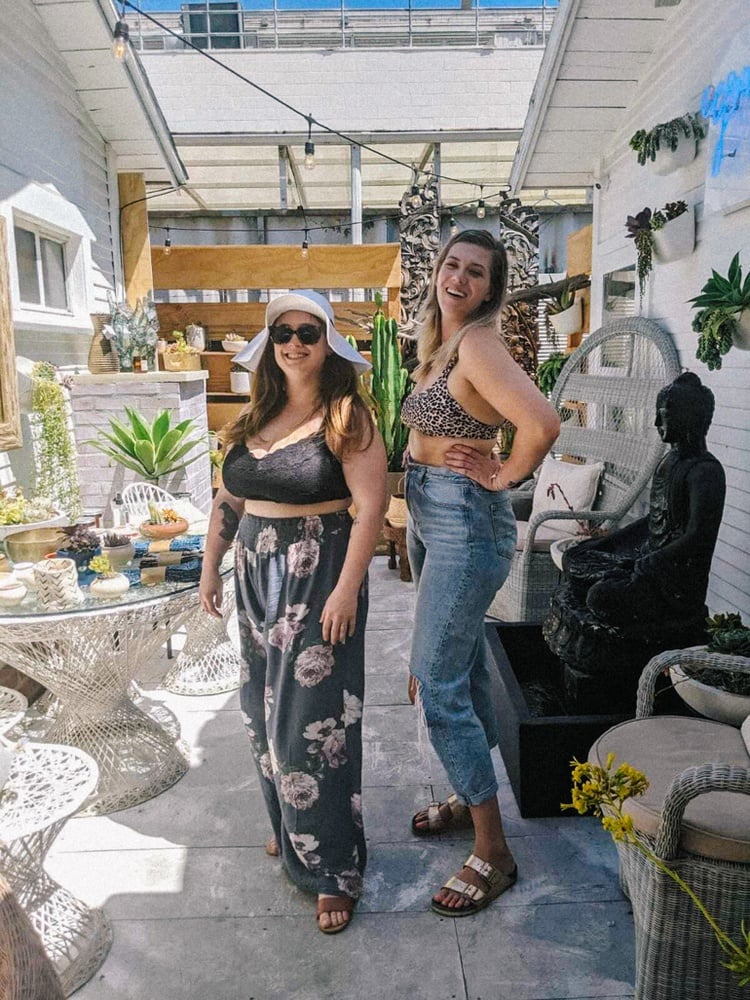
Even though it is not my responsibility to change the reactions of others (hello, patriarchy!), I knew in the back of my mind that I had a tool to make my life more comfortable, both physically and emotionally. After sitting on the idea for over a decade, I decided this past spring that I wanted to seriously consider having a breast reduction procedure. The girl who once vowed to never have a non-emergency surgery was finally ready to go under the knife.
This is my breast reduction story. No two people are going to have the same experiences when it comes to anything, but especially when navigating healthcare. My story cannot be generalized to everyone, but I hope I can shed some light on the basics of the procedure and some common questions I know I had when I first started researching! Always seek professional medical advice when it comes to your health.

All About Breast Reduction Surgery
The first thing I did in my journey was find a board certified plastic surgeon in my area. After some googling, I found a surgeon who resonated with me because of her expertise specifically in breast procedures. Plastic surgeons come in all shapes and sizes and specialties: some perform exclusively on trauma-related injuries (my brother had seen a plastic surgeon after being attacked by a dog as a child), while others prefer to do more elective, cosmetic procedures.
You’ve probably heard of various plastic surgery procedures, such as breast implants, body lifts, tummy tucks, Brazilian butt lifts, and liposuction. Apart from surgical procedures, plastic surgeons also very commonly perform more superficial treatments, like Botox injections, spider vein treatment, laser skin resurfacing, and other types of skin care.
When it comes to breast procedures in particular, breast reconstruction surgery often involves augmentation or reduction. This can include getting breast implants, breast implant removal, breast implant revision, breast lifts, breast reductions, medical mastectomies, lumpectomies, and gender confirmation procedures. Some of these can even be combined- someone getting a reduction, for example, commonly also gets a breast lift and sometimes even small implants to achieve their ideal size and shape.
People look into these procedures for a wide variety of reasons, and no reason is less valid than the next. Before I dove head first into this community, I had a preconceived notion about cosmetic procedures- that they were vain, unnecessary, and a waste of money. This couldn’t be further from the truth!
Working through my own biases about plastic surgery was pivotal in my journey and almost certainly made everything a lot easier mentally!
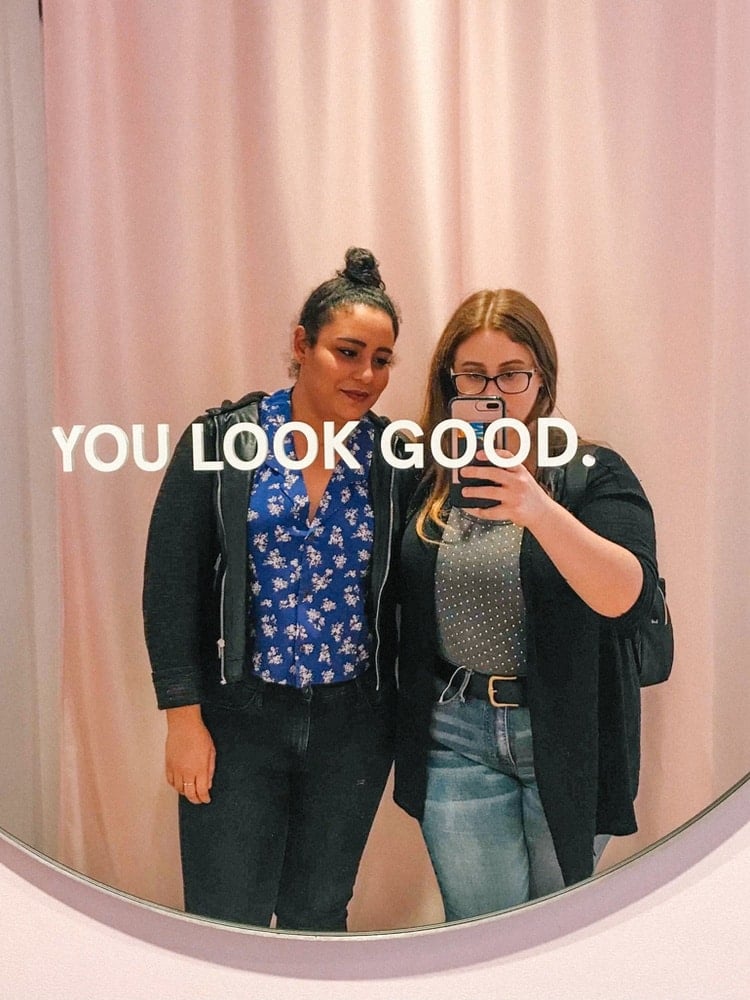
At the end of April, I met with my first choice surgeon and I felt instantly comfortable with her. She told me that there are a few different types of breast reductions- the most common involves an incision around the areola and down the center of the breast (called a lollipop incision), and sometimes it includes an additional incision underneath the breast (called an anchor incision). It is through those incisions that the surgeon removes the excess tissue, fat, and skin from the breasts.
Whether a patient has a lollipop or an anchor procedure depends on a variety of factors, such as surgical technique, size of the reduction, and whether or not a breast lift is included. The other, less common, kind of breast reduction actually involves simply liposuctioning the excess fat out of the breasts through small incisions typically in the armpit. Although it is less invasive, this kind of procedure isn’t ideal for most people because liposuction does not remove excess skin or provide the lift that a traditional breast reduction does. Note: These are not the only types of incisions and reductions, just the most common and the only ones my surgeon told me about.
Unsurprisingly, she recommended the traditional procedure for me, noting that my specific needs were mostly going to be excess skin removal and a breast lift. My H-cup breasts were mostly skin, not fat or tissue, and hung down almost to my stomach. Post-op, the goal was to become either a C or a D-cup. A breast reduction before and after can’t ever be guaranteed and has to do with their body shape and structure.
I have fairly broad shoulders which, in turn, means I have wide breasts. This isn’t a factor that can be changed; if my surgeon went any smaller than a C or D, I could run into blood-flow issues and potentially cause nipple necrosis or even complete nipple loss! Even becoming a D-cup felt like an impossible feat, but I trusted that she would do what was best for long-term success.
No medical procedure, medication, or treatment comes without risks, however. A breast reduction is no exception. Breast reduction surgery side effects vary greatly, but can include pain, swelling, redness, numbness, infection, and temporary or permanent loss of nipple sensation, loss of breast feeding ability, and skin and/or nipple necrosis. There are ways to reduce these possibilities, such as proper wound care and alerting your surgeon to any suspicious changes or feelings as soon as possible.
There are also cosmetic side effects, such as dissatisfaction with the shape, size, or look of the reduced breasts, uneven left and right breasts, and large surgical scars. These are all things to discuss with your surgeon if you are considering having a reduction or any other kind of cosmetic procedure.
Something in my gut told me to schedule the surgery. Even though I was scared, the benefits seemed to greatly outweigh the risks. My surgeon explained that while a breast reduction is a major surgery, the recovery tends to be on the mild side. Most patients do not require pain medication any stronger than Tylenol, and are able to care for themselves normally after about two weeks. A few weeks later, I called the office and said I wanted to go for it- suddenly I was having surgery on June 3rd!
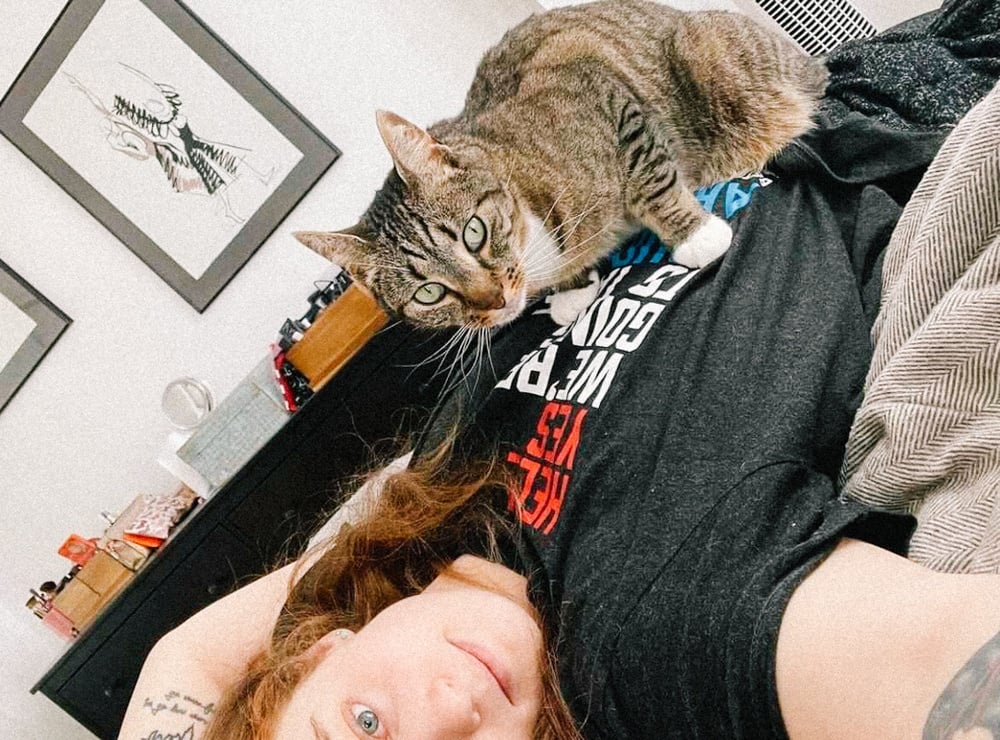
Should I Have A Breast Reduction?
The most shocking thing, when I look back on my experience, is how easy it all was for me. This, of course, isn’t the case for everyone, but it does seem to be quite common for folks who have breast reductions. It helped that I had a friend who had undergone the same surgery a year prior; whenever I had a question, she was ready with a first-hand response.
I also started lurking in breast reduction forums online. Many people in these forums were considering breast reductions, like me, and the community was overwhelmingly helpful, kind, and compassionate. Most notably, not a single person I read about had any regrets with their decision. Even those who had pain, complications, or infections ultimately were glad they went through with it. That sense of camaraderie really helped me stay calm for the weeks between scheduling my surgery and actually going under the knife.
I also stayed busy by doing everything I could to prepare for my recovery. It was almost like nesting; I went to Target and bought what I had decided were essentials- protein shakes (extra protein can be helpful in the healing process), Tylenol, over-the-counter anti-nausea medicine, and comfy pajama pants. I booked a flight for my mom to come stay with me for 10 days so my fiance wouldn’t have to juggle working, caring for me, and caring for our pets by herself.
I stocked up on soft and easy-to-digest foods at the grocery store so I wouldn’t have to think about what to eat after everything was said and done. I thought back to my wisdom teeth removal three years prior and remembered which foods I had gravitated toward- juice pops, Gatorade, plain pasta, and even baby food! Finally, I ordered a comfy pillow off of Amazon as a treat to myself. Soon enough, I was set.
My surgeon provided everything I would need on the medical side. Apart from sending me home with more than enough gauze, prescription nausea medication, arnica tablets (a homeopathic way to reduce bruising and swelling), and antiseptic soap, she also took care of scheduling my post-op appointments, including a physical and bloodwork with my primary care doctor, an EKG to make sure my heart was healthy for surgery, a mammogram, and a breast ultrasound.
Not everyone is required to have a mammogram and/or ultrasound before surgery, but if you are able to do it, I highly recommend it. My grandmother is a breast cancer survivor and even though I had genetic testing in college to see if I had the same problematic genes that she does (BRCA 1 and 2- I have neither!), my surgeon decided it was best to be as careful as possible and make sure everything was healthy before proceeding.
I later found out that many young people worry about having mammograms. This isn’t something I ever worried about, probably because my mom always told me that they were quick, easy, and relatively painless. She was right- the worst part was getting the ultrasound gel off of me after it was over. The mammogram itself didn’t hurt, it took only a few moments, and the ultrasound techs were incredibly helpful and kind. Then before I knew it, it was surgery day.
Surgery (And Recovery) Were A Breeze
Obviously, I can’t say for sure how everything went while I was under anesthesia. But it felt like one moment I was in the OR and then I blinked and was suddenly in the recovery room. The anesthesia part was probably my biggest fear, as it was my first time going under general anesthesia. My only other experiences had been with conscious sedation for my wisdom teeth removal and an upper endoscopy.
I told my anesthesiologist my fears and she reassured me that it was her job to do everything to keep me both pain-free and safe. She did a great job because even though I had a lot of anxiety as I came out of anesthesia, I didn’t feel much pain, I wasn’t nauseous, and even the anxiety went away after I oriented myself to where I was and what had happened.
I remember looking at my chest and being amazed, even with the swelling, gauze, and bandages. Immediately, I was thrilled that I had gone through with surgery, and I couldn’t wait to see how things felt and looked as time went on. After hanging out in the recovery room for a bit, my doctor said she would call the following day to see how I was doing, and my mom drove me from the office to the hotel I had opted to stay in for the first few days- mostly so my cats didn’t attempt to lay on me, as they tend to do.
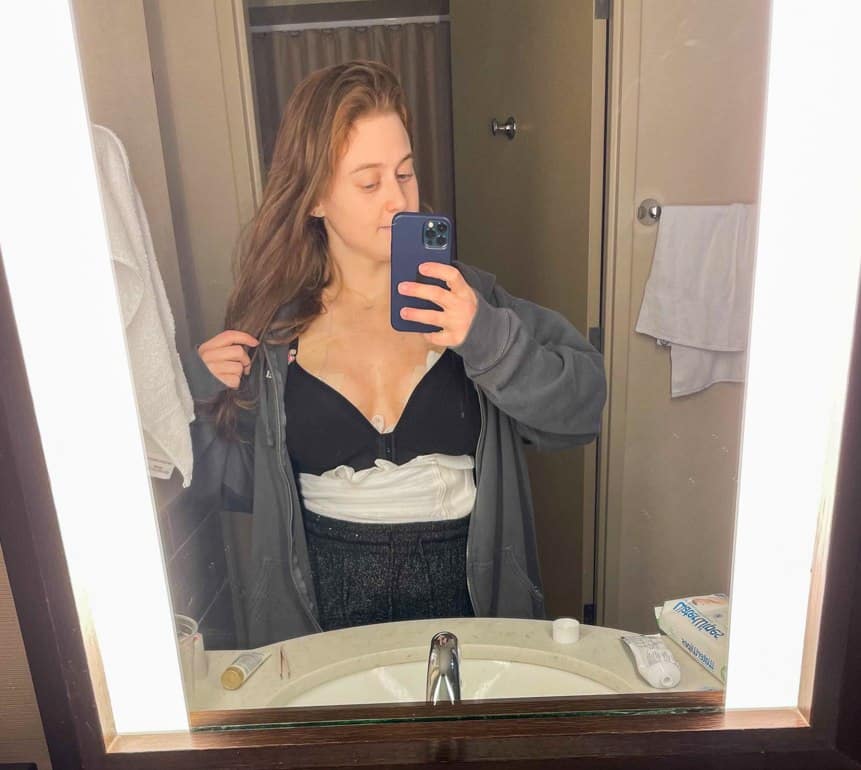
The worst pain I felt was in the car ride. It felt like a dull but painful burning in my chest and it was hard to get comfortable. Of course, we hit some typical Manhattan rush hour traffic, so that certainly didn’t help anything! After having a few Wheat Thins crackers, I took some Tylenol and before I knew it, the pain was almost completely gone. I kept waiting for the pain to come back, but it never really did.
I needed help getting in and out of bed for a few days, but even that became easier the more I did it. I made sure to get up every few hours and walk around to reduce my risk of blood clots (as you should do with any surgery), and by the time I left the hotel and walked the stairs up to my 5th floor apartment, I felt like I could take on anything. In fact, my fiance and my mom had to constantly remind me to slow down and let them take care of me!
Three Months Later, And I Haven’t Looked Back
I am so blessed that my experience has been overwhelmingly positive. None of my stitches split, nothing became infected, the pain was almost non-existent, and the swelling has been manageable. Even the scars have already started to lighten, although I know that will take a considerable amount of time to fade to their final size and color. I am so glad I had a breast reduction. I started to wonder why I hadn’t done this before, back when my mom first mentioned it to me.
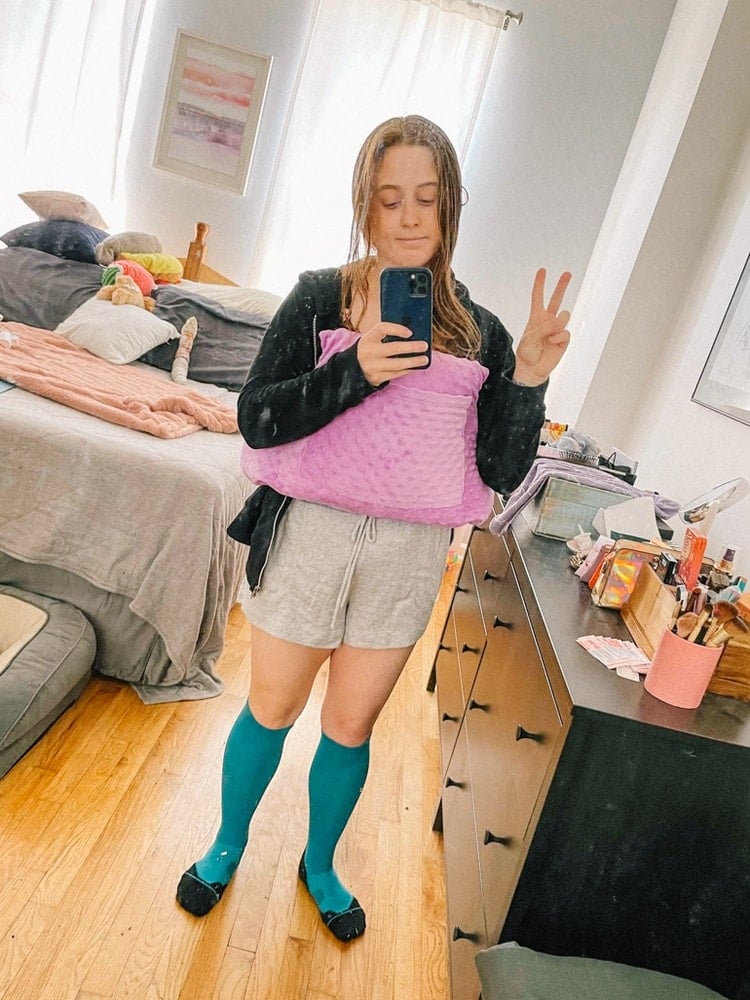
Ultimately, I think the timing was right for me to do it during the early summer of 2021. While I can’t guarantee it would’ve mattered, I’m glad I gave my breasts time to fully mature during my 20s. My breast size at 18 was considerably smaller than my breast size at 27- which is totally normal! Our bodies weren’t meant to stop growing in our teens, no matter what society tries to tell us. It would’ve been such a disappointment to have a reduction at 18 and then have them continue to grow post-op.
While that still could happen as I enter my 30s, the likelihood is much lower. I’ve also done a lot of emotional growth throughout my 20s, and I am not sure I was really ready to have surgery any time before now. Getting through surgery has made me realize that there are so many things I am capable of, even if they seem scary. It may seem like a silly life lesson, maybe one I should’ve realized when I was younger, but tackling a major fear head-on has really helped me to put other things into perspective.
Since having surgery, my clothes feel so much more comfortable on my body. I am no longer married to an underwire bra, and I’ve had fun wearing bralettes, sports bras, and even strapless things! I used to feel most comfortable in oversized tees, but now I am having fun exploring crop tops and body-con clothes! While my lower back pain hasn’t gone away (I know I have a herniated disc and need to go to physical therapy), my shoulders and neck feel considerably less tense and I have had far fewer headaches.
My center of gravity has changed significantly, which has been immensely helpful for riding my horse. After 6 weeks off of riding (talk about torture!), I had my riding instructor record parts of my lesson so I could see. The differences in my riding has been the most amazing change for me. I am no longer leaning so far forward that I am throwing my horse off balance. I can sit up straighter, and I feel much more correct and in control of myself. That alone makes the whole thing worth it.
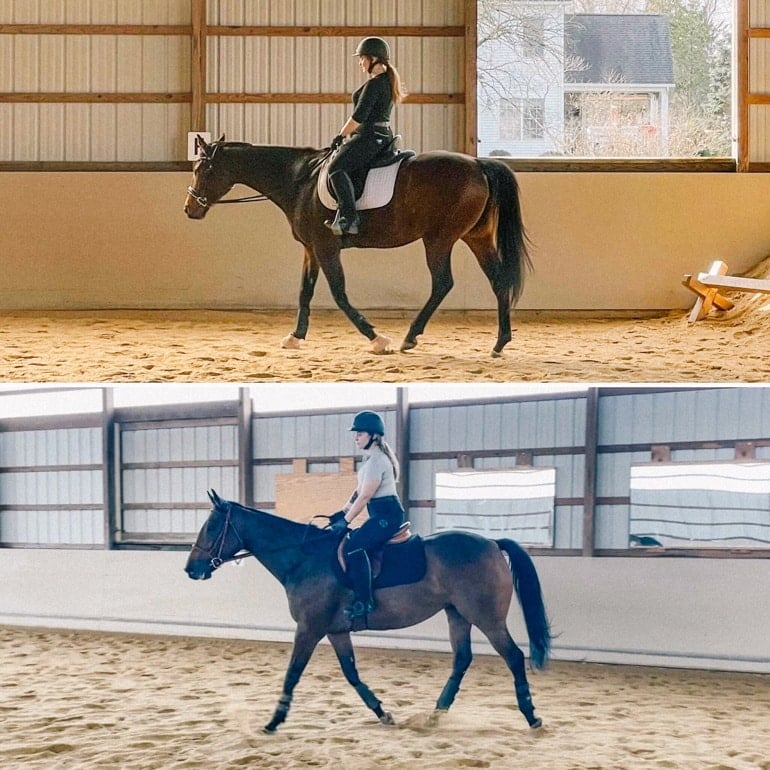
I know that my body will continue to grow and change the older I get. As I mentioned before, it is possible that my breasts will grow as well, possibly even to my pre-op size. While the likelihood isn’t as high as it would’ve been had I done the procedure in my teens, I am also okay with that fact. I know that at whatever size, my body is worthy of love and respect not just from other people, but also from myself. And hey, worst case scenario I can have another reduction… that is, if it is financially feasible.
Speaking of affordability…
But Wait- What About Insurance?
The topic I have purposefully left out of this piece until now also happens to be the number one question I get when I talk to people about my reduction: Did your health insurance cover your procedure? I know people don’t specifically care if my health insurance company covered my reduction- they want to know if their health insurance company would cover their hypothetical reduction.
This is an incredibly valid question, since most people don’t know how much a breast reduction even costs in the United States; the average breast reduction costs around $5,500 dollars without insurance– and that’s just the procedure! There are other costs, too, such as surgical fees, operating room fees, hospital stays (if necessary), and anesthesia. This average also varies greatly by region- a breast reduction in Miami will typically cost much less than a breast reduction in San Francisco or New York.
As much as I wish I could wave a magic wand and make breast reductions (and all other medical costs) free for everyone, I can’t. There is no way for me to answer the insurance question accurately, since it is going to be vastly different for everyone.
Because the United States operates (mostly) with a for-profit healthcare system, at the end of the day, insurance providers want to deny your claims. They want to not cover services because it saves them money, while drowning you in debt. The most important piece of advice that I can give someone who is looking into a breast reduction is to contact your insurance early and contact your insurance often. Find out their requirements before speaking to a possible surgeon. Their requirements will, ultimately, dictate who can perform your surgery, how much they need to remove from your chest, and what kinds of pre-existing conditions you need to have documented.
While all insurance companies (and even individual plans under the same company) will have different requirements, there are some that I have found to be fairly standard across the board. The first requirement that most insurance policies have to cover a breast reduction is using an in-network surgeon. An in-network provider has the benefit of being an American Society of Plastic Surgeons (ASPS) member surgeon who has been vetted by the insurance company and financially participates with them.
While many out-of-network surgeons are also ASPS member surgeons, picking someone in-network takes away the responsibility of you figuring out if they are or aren’t. The downfall of being tied to an in-network provider is that it narrows your scope of who can and can’t do your procedure- this is especially an issue in large cities like New York, where the vast majority of medical professionals do not participate with insurance providers at all.
The second requirement that most insurance policies have to cover a breast reduction is documenting pre-existing conditions. Insurance companies first and foremost want you to remedy your problems with cheaper methods first. They also want to make sure that they think you absolutely need this procedure (even though it shouldn’t be their decision in the first place).
This may include MRIs of your back to show damage caused by large breasts, documentation of under-breast rashes that haven’t gone away with topical treatment, and bruises or marks on your shoulders from bra straps digging in (often referred to as shoulder grooves). They may also require a letter from a primary care physician or proof that you attempted at least six months of physical therapy without success. This is why it is so important to find out what your particular plan requires so you can get ahead of checking the boxes for your own success.
The final requirement that most insurance policies have to cover a breast reduction is a specific weight to be removed. Breast reduction weight requirements vary not only by the insurance company but by the structure of the individual person. While the amount may seem arbitrary, most insurance companies use something called the Schnur Sliding Scale. According to Rosenberg Plastic Surgery in Beverly Hills, the Schnur Sliding Scale is, “a chart used in evaluating a patient’s medical requirements when considering breast reduction surgery [by] compar[ing] the patient’s body surface area by the weight of breast tissue to be removed in surgery.”
The formula used isn’t exactly easy for non-medical professionals to figure out, but a plastic surgeon should be able to guide you through it. There are downsides to this scale, however. Because breast density varies person to person and includes skin, muscle, ducts, and fat, two people of identical size and shape may need or want vastly different outcomes. Taking too much weight away from the breasts can also increase the likelihood of necrotic tissue and permanent loss of nipple sensation. If your breasts are wide-set, for example, removing a large amount of the breasts can damage the blood flow systems within the body, thus increasing the possibility of necrosis.
For many people, meeting insurance requirements for a covered procedure is manageable and is done successfully. For others, that’s not the case. Paying out-of-pocket for a breast reduction is always an option, but is a privilege that not everyone can afford. Not only does insurance coverage and requirements vary so greatly, but the desired outcomes both physically and cosmetically vary greatly between individual people. Because of this, while it is very tempting and natural to ask someone what their insurance covered or how they paid for their reduction, it is best to direct that question to your own insurance provider.
No Regrets – Just (Self) Love
While I know that plastic surgery is not for everyone, in no way do I regret my breast reduction. In fact, as the summer season comes to a close and we head into fall, I can safely say that having surgery was the best thing I did during the summer of 2021. My pain was minimal, my recovery was easy, and my scars do not bother me in the slightest. I know they will continue to fade, but even the fresh purple color wasn’t a deterrent. For me, all of that was worth my newfound comfort, confidence, and body positivity.
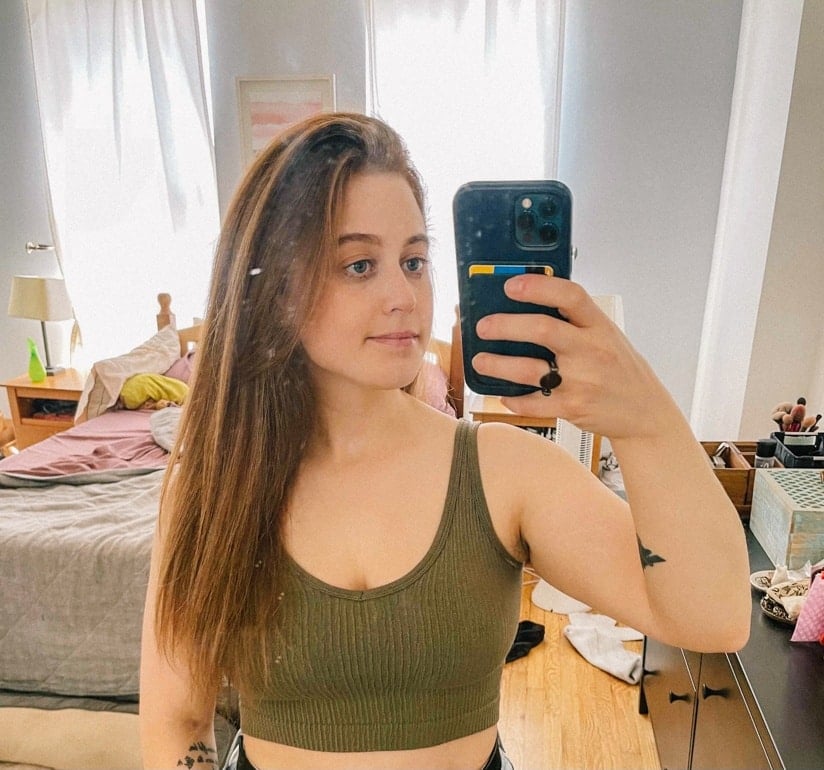
Save for a few exceptions, no one’s body ever needs cosmetic surgery. It is difficult to be a human being in this world, what with the pressures of diet culture, fatphobia, Western beauty standards, misogyny, and white supremacy all around us, telling us how we should look and at what size.
For more information about how these standards have affected us all throughout time and space, Whimsy Writer Kerasa wrote a great piece about it here. It is also true that cosmetic surgery can perpetuate those problems. While some may not agree with me, I think that as long as you are doing these procedures because you specifically want to, you understand the psychological impact, and you are prepared for the body changes, cosmetic surgery can also be a powerful tool for your own bodily satisfaction.
Your worth does not change according to your size or shape, but sometimes your physical comfort can. That is exactly what I discovered during this process. I am still me, whether I have H-cup or C-cup breasts. I am still worthy of respect, love, and dignity. But after having my breast reduction surgery, I am much more comfortable, confident, and eager to take on the world.

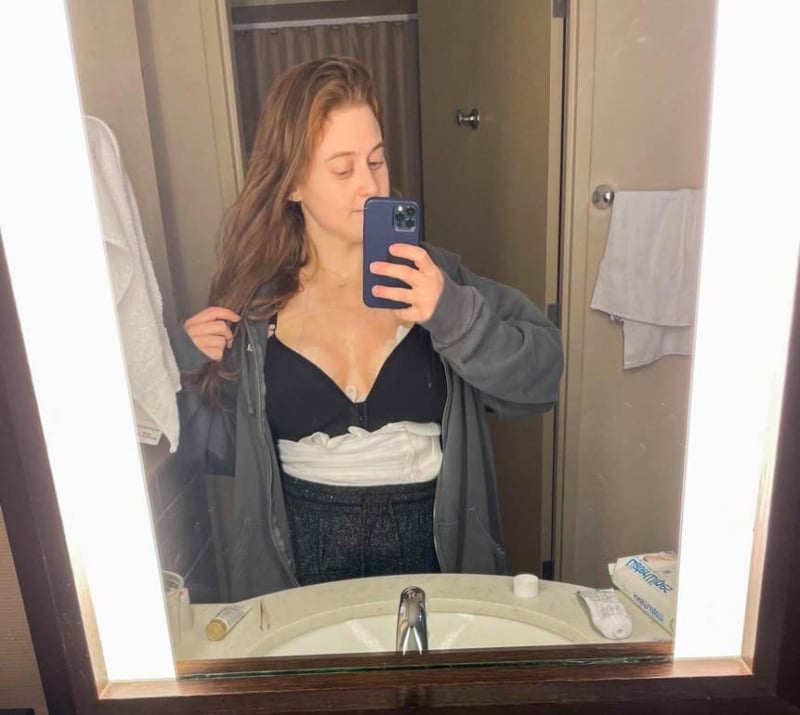
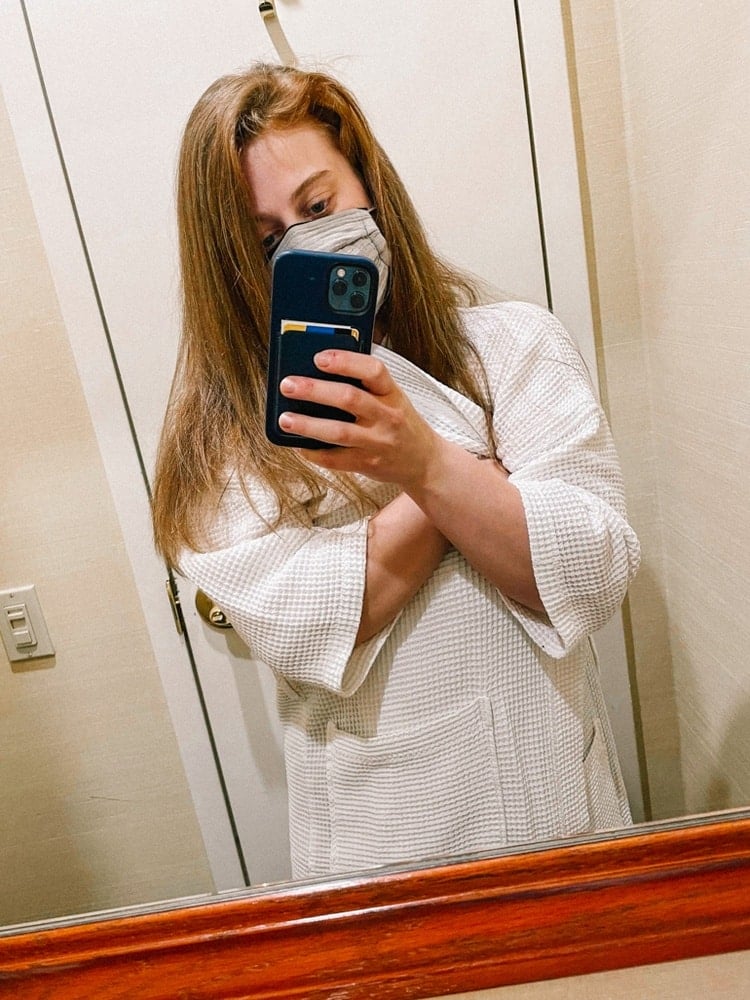
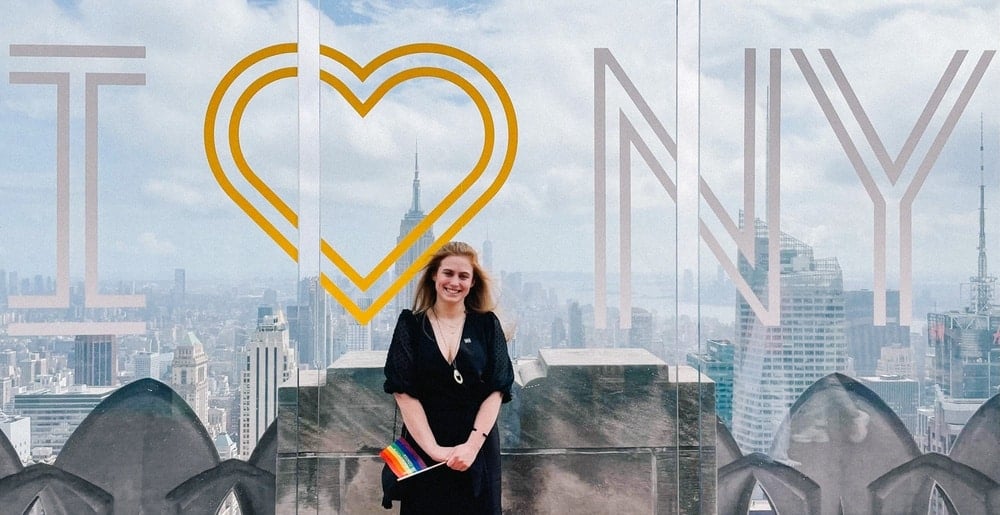

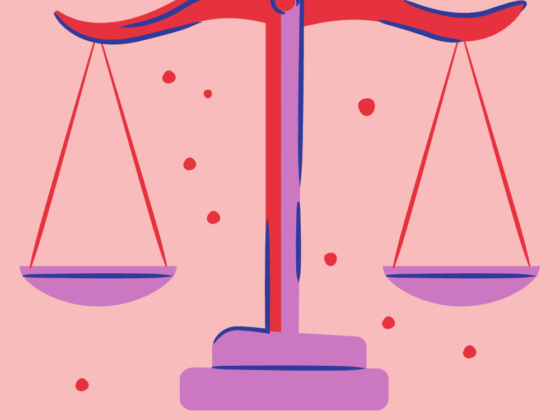

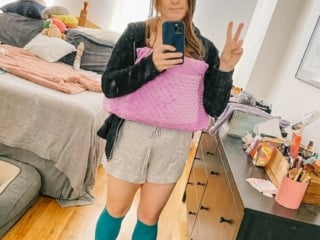
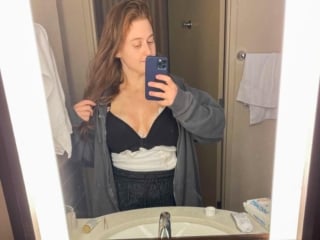
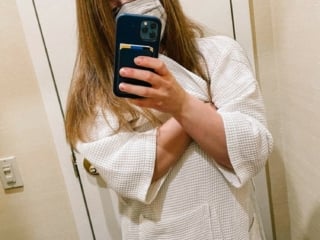


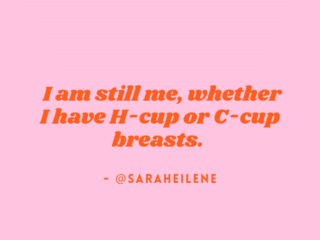
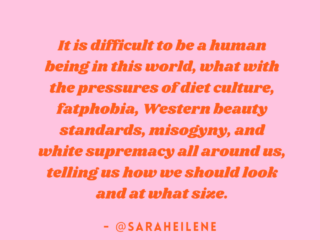
7 comments
I am 19 with a 36DDD.Big breasts run in our family and almost everyone has them but for me am a very small frame and this causes alot of physical pain honestly.Especially breast pain and chest pain not forgeting back pain!Okay for me i can live like this for the next ten years or so but what scares me is the fact that i will never excersice and dance since i do love dancing.Am also great in fashion but i have to wear baggy clothes.Bruh i have been told severally i look 30 but am only 19😏ps:am not overweight am the smallest in fact.Am battling deep anxiety and depresion.Lord i hope it doesnt kill me.Even if i was to consider a reduction am financially poor.May God give me the strength💔💔💔💔
Thank you for this honest description of your experience. My daughter is a candidate for this surgery and it really helped me to read your thoughts and physical details. Two of my friends had this procedure back in the ‘70’s and both told me their only regret was that they hadn’t done it sooner! One was just 19 years old and the other 22. It changed their lives in very positive ways.
May you continue your journey with joy and good health! 💕
I have surgery on Friday and am so excited! Thanks for writing your reflection and process. Super encouraging and helpful. Also love all your grounded and aware ways of acknowledging self and worthiness.
Looking forward to having my positive story to share!
The cat concern is real! I’m wondering what mine will do when his shelf is gone XD
What a fantastic guide for crystal newbies! 🌟 I love how you break down the basics, making it super accessible. Your point about crystals serving as reminders of our intentions really resonated with me—kind of like having a little sparkly post-it note for our souls. Quick question: Do you have a favorite crystal for when you’re feeling particularly frazzled? I find myself reaching for amethyst when my brain feels like a browser with too many tabs open. 🧘♂️ Your emphasis on ethical sourcing is so important. I recently learned that some crystals are actually heat-treated or dyed—who knew we had designer crystals?! It’s great to see someone addressing these issues head-on. And the humor sprinkled throughout was perfect. I chuckled at the bit about forming a relationship with your crystals. Do you think they get jealous if we neglect them for a while? 🤔 Seriously though, thanks for such an enlightening read, and can’t wait to start my own mindful crystal collection, starting small as you suggested.
Sweet site, super design, real clean and utilize pleasant.
my ex-boyfriend dumped me 7 months ago after I caught him of having an affair with someone else and insulting him. I want him back in my life but he refuse to have any contact with me. I was so confuse and don’t know what to do, so I visited the INTERNET for help and I saw a testimony on how a spell caster help them to get their ex back so I contact the spell caster and explain my problems to him….. he cast a spell for me and assure me of 15 hours that my ex will return to me and to my greatest surprise the third day my peter came knocking on my door and beg for forgiveness. I am so happy that my love is back again and not only that, we are about to get married. Once again thank you Dr Okosun , you are truly talented and gifted contact him on WhatsApp +2348054338132 Okosunspelltemple33@gmail.com